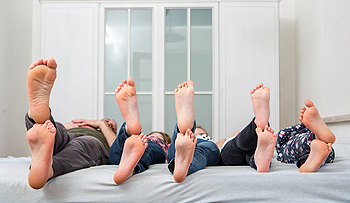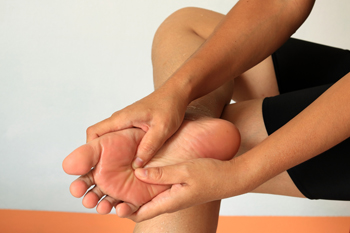Items filtered by date: July 2022
Causes of Overlapping Toes

Of the many possible congenital foot problems that may manifest at some point during your life, overlapping toes are among the most common. This condition can occur when one or more toes overlap others in a seemingly permanent way. This condition most commonly involves the pinky toe, but in some cases, the big toe and the second toe might also be affected. There are several potential causes of overlapping toes to be aware of. Frequently, overlapping toes can be caused by hereditary issues. For example, you may have inherited a bone structure in your feet that makes overlapping toes more likely. Additionally, overlapping toes may be caused by the wearing of certain kinds of footwear. For instance, wearing high heels or pointy-toe shoes for prolonged periods can twist the toes into unnatural positions that may eventually lead to this condition. Other shoes that have small toe boxes can produce a similar effect. Lastly, aging can be a cause of overlapping toes. As an individual ages, their toes naturally roll in more which can lead to overlapping toes. If you believe you have overlapping toes or are at risk of developing this condition, reach out to a podiatrist.
Congenital foot problems require immediate attention to avoid future complications. If you have any concerns, contact Dr. Tupper of Coshocton Foot Health Center. Our doctor can provide the care you need to keep you pain-free and on your feet.
Congenital foot problems are deformities affecting the feet, toes, and/or ankles that children are born with. Some of these conditions have a genetic cause while others just happen. Some specific foot ailments that children may be born with include clubfeet, polydactyly/macrodactyly, and cleft foot. There are several other foot anomalies that can occur congenitally. What all of these conditions have in common is that a child may experience difficulty walking or performing everyday activities, as well as trouble finding footwear that fits their foot deformity. Some of these conditions are more serious than others. Consulting with a podiatrist as early as possible will help in properly diagnosing a child’s foot condition while getting the necessary treatment underway.
What are Causes of Congenital Foot Problem?
A congenital foot problem is one that happens to a child at birth. These conditions can be caused by a genetic predisposition, developmental or positional abnormalities during gestation, or with no known cause.
What are Symptoms of Congenital Foot Problems?
Symptoms vary by the congenital condition. Symptoms may consist of the following:
- Clubfoot, where tendons are shortened, bones are shaped differently, and the Achilles tendon is tight, causing the foot to point in and down. It is also possible for the soles of the feet to face each other.
- Polydactyly, which usually consists of a nubbin or small lump of tissue without a bone, a toe that is partially formed but has no joints, or an extra toe.
- Vertical talus, where the talus bone forms in the wrong position causing other bones in the foot to line up improperly, the front of the foot to point up, and the bottom of the foot to stiffen, with no arch, and to curve out.
- Tarsal coalition, when there is an abnormal connection of two or more bones in the foot leading to severe, rigid flatfoot.
- Cleft foot, where there are missing toes, a V-shaped cleft, and other anatomical differences.
- Macrodactyly, when the toes are abnormally large due to overgrowth of the underlying bone or soft tissue.
Treatment and Prevention
While there is nothing one can do to prevent congenital foot problems, raising awareness and receiving neonatal screenings are important. Early detection by taking your child to a podiatrist leads to the best outcome possible.
If you have any questions please feel free to contact our office located in Coshocton, OH . We offer the newest diagnostic tools and technology to treat your foot and ankle needs.
Flip Flops May Cause Foot Pain

The simplicity of wearing flip flops is attractive to many people. They are available in many colors and styles, and are easy to slip on in a hurry. Despite their popularity, research has indicated they may cause foot problems. People commonly notice heel pain, and this can be a result of an absence of an arch in the shoe. Additionally, a pain in the big toe may be indicative of a bunion forming, and the toes may ache from constantly trying to keep the flip flop on the foot. A reason the foot muscles work harder when flip flops are worn may have to do with being an open back shoe. Most flip flops do not have a strap on the back, and the gait, or walking style, can be negatively affected. It is beneficial to perform exercises and stretches that can strengthen the foot and calf muscles, which may make it more comfortable to walk. If you would like additional information about what type of flip flops to wear that are good for the feet, please confer with a podiatrist.
Flip-flops can cause a lot of problems for your feet. If you have any concerns about your feet or ankles, contact Dr. Tupper from Coshocton Foot Health Center. Our doctor will assist you with all of your foot and ankle needs.
Flip-Flops and Feet
Flip-flops have managed to become a summer essential for a lot of people. While the shoes may be stylish and easy to slip on and off, they can be dangerous to those who wear them too often. These shoes might protect you from fungal infections such as athlete’s foot, but they can also give you foot pain and sprained ankles if you trip while wearing them.
When Are They Okay to Wear?
Flip-flops should only be worn for very short periods of time. They can help protect your feet in places that are crawling with fungi, such as gym locker rooms. Athlete’s foot and plantar warts are two common fungi that flip-flops may help protect your feet against.
Why Are They Bad for My Feet?
These shoes do not offer any arch support, so they are not ideal for everyday use. They also do not provide shock absorption or heel cushioning which can be problematic for your feet. Additionally, you may suffer from glass cuts, puncture wounds, and stubbed toes since they offer little protection for your feet.
More Reasons Why They Are Bad for Your Feet
- They Slow You Down
- May Cause Blisters and Calluses
- Expose Your Feet to Bacteria
If you have any questions, please feel free to contact our office located in Coshocton, OH . We offer the newest diagnostic and treatment technologies for all your foot care needs.
The Link Between Childhood Obesity and Flat Feet

Individuals that suffer from obesity are naturally at a higher risk of experiencing a variety of foot ailments and foot pain. One important link between obesity and foot health that every parent should be aware of is the relationship between childhood obesity and flat feet. When an individual has flat feet, their entire soles rest flush against the ground and lack an arch. Although a flat foot does not always cause symptoms, the condition can cause foot pain and eventually contribute to back pain. Scientific studies have demonstrated that obese children were more likely to exhibit flat feet than other non-obese children. Experts have identified two potential explanations for this phenomenon. First, obese children may simply have more fat padding on the bottoms of their feet. And second, obese children may have sunken arches because of the extra weight that they exert on their feet. If your child suffers from obesity and you believe that they may be exhibiting signs of flat feet, it may be wise to contact a podiatrist. A professional will be able to help you identify any problems with your child’s feet and develop a plan to address them.
The more you weigh, the harder your feet must work to support your body. If you’re an obese individual and are concerned about your feet, contact Dr. Tupper from Coshocton Foot Health Center. Our doctor can provide the care you need to keep you pain-free and on your feet.
Obesity and Your Feet
People who are overweight are putting more pressure on their ankles, knees, and hips as well as their feet. This unfortunately can lead to variety of different issues.
Problems & Complications Stemming from Obesity
- When the body is overweight, it tries to compensate by changing the way that it moves. An obese person may lean forward and put extra weight on the wrong part of the foot. This puts unnecessary stress on the feet.
- Obese people are also more likely to develop type II diabetes which is a condition that causes a lot of foot problems. People with diabetes often don’t feel the cuts and sores that they may have on their feet, which can lead to more complicated and severe issues.
- Plantar fasciitis is another foot condition that can be caused by obesity. Plantar fasciitis is an inflammation of the tissue along the bottom of the foot, which causes pain and stiffness while walking and climbing stairs.
If you have any questions, please feel free to contact our office located in Coshocton, OH . We offer the newest diagnostic and treatment technologies for all your foot care needs.
Causes of Numbness in the Feet

Sometimes your foot “goes to sleep” as the result of sitting awkwardly or wearing tight shoes. This is a temporary condition and in most cases, it resolves itself easily. Other causes of numbness in the feet and toes can be problematic as well as dangerous to your health. It can often be traced to a nerve damage that causes the feet to stop receiving transmissions from the brain, also known as peripheral neuropathy. Another common cause is damage to the circulatory system. Blood vessels become constricted and cannot supply the proper amount of blood to the area, causing peripheral artery disease (PAD). Diabetes, systemic diseases, vitamin deficiency, and alcoholism also can contribute to this condition. Physical conditions, including a herniated disc and spinal stenosis, can lead to numbness in one or both feet. Deep vein thrombosis (blood clots), extreme cold, atherosclerosis (a thickening of arterial walls), and Raynaud’s disease may cause numbness in the lower extremities. Caution is the byword when numbness, tingling and burning sensations in the feet and toes occur or won’t subside. Please consult a podiatrist as soon as possible for a diagnosis and appropriate treatment measures.
Neuropathy
Neuropathy can be a potentially serious condition, especially if it is left undiagnosed. If you have any concerns that you may be experiencing nerve loss in your feet, consult with Dr. Tupper from Coshocton Foot Health Center. Our doctor will assess your condition and provide you with quality foot and ankle treatment for neuropathy.
What Is Neuropathy?
Neuropathy is a condition that leads to damage to the nerves in the body. Peripheral neuropathy, or neuropathy that affects your peripheral nervous system, usually occurs in the feet. Neuropathy can be triggered by a number of different causes. Such causes include diabetes, infections, cancers, disorders, and toxic substances.
Symptoms of Neuropathy Include:
- Numbness
- Sensation loss
- Prickling and tingling sensations
- Throbbing, freezing, burning pains
- Muscle weakness
Those with diabetes are at serious risk due to being unable to feel an ulcer on their feet. Diabetics usually also suffer from poor blood circulation. This can lead to the wound not healing, infections occurring, and the limb may have to be amputated.
Treatment
To treat neuropathy in the foot, podiatrists will first diagnose the cause of the neuropathy. Figuring out the underlying cause of the neuropathy will allow the podiatrist to prescribe the best treatment, whether it be caused by diabetes, toxic substance exposure, infection, etc. If the nerve has not died, then it’s possible that sensation may be able to return to the foot.
Pain medication may be issued for pain. Electrical nerve stimulation can be used to stimulate nerves. If the neuropathy is caused from pressure on the nerves, then surgery may be necessary.
If you have any questions, please feel free to contact our office located in Coshocton, OH . We offer the newest diagnostic and treatment technologies for all your foot care needs.


